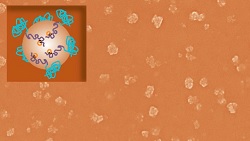 |
| Vaccinating nanoparticles with graphical inset showing proteins on the surface of one nanoparticle.--Courtesy of UW |
To be able to make vaccines on site simply and effectively would greatly benefit remote areas that are often hampered by both distance from the source of vaccines and the difficulty of refrigeration. And researchers at the University of Washington have developed a nanotech delivery solution that could give vaccinators a leg up in the field.
The team of engineers created a nanoparticle with a protein on its surface designed to mimic an infection in the body, prompting an immune response, according to a UW report. The protein binds to calcium phosphate, found in teeth and bones, and the nanoparticle carries the protein to the lymph nodes, where it comes in contact with dendritic cells. These immune cells are crucial instigators of an immune response.
In the study, mice injected with the nanoparticle made three times the number of T cells, indicating an immune response, than mice with just the protein.
The reason for the nanoparticle delivery is to trick the immune system into acting as if it is encountering a normal pathogen, much the way a traditional vaccine works. But the one-size-fits-all aspect of the nanoparticle-protein combination could lead to a quick, shake-and-bake type of manufacturing process.
"We're really excited about this technology because it makes it possible to produce a vaccine on the spot," said Francois Baneyx, lead author of the study in the journal Nanomedicine, in a statement. "For instance, a field doctor could see the beginnings of an epidemic, make vaccine doses right away and blanket vaccinate the entire population in the affected area to prevent the spread of an epidemic."
For developing countries, an easy-to-make vaccine could help cut costs because the proteins could be shipped in a dry formulation without refrigeration. All a vaccinator in the field would need to ready the solution of freeze-dried or dehydrated nanoparticles would be water, calcium and phosphate, according to the report.
The UW team gathered funding from the National Institutes of Health and a Grand Challenges Explorations grant from the Bill & Melinda Gates Foundation.
- here's the UW report
- and here's the Nanomedicine abstract